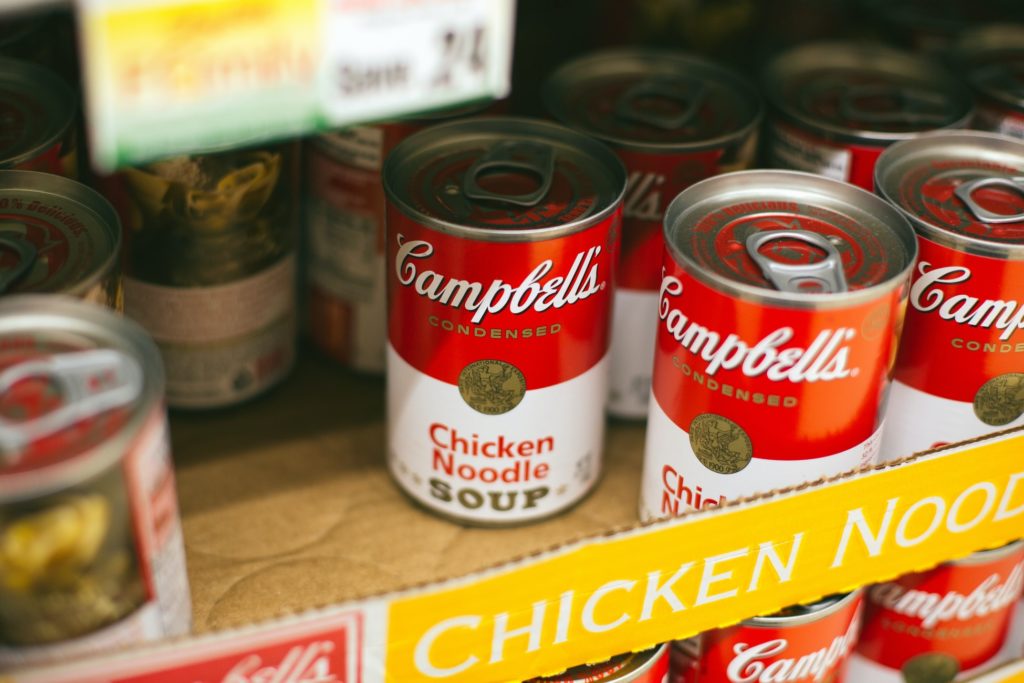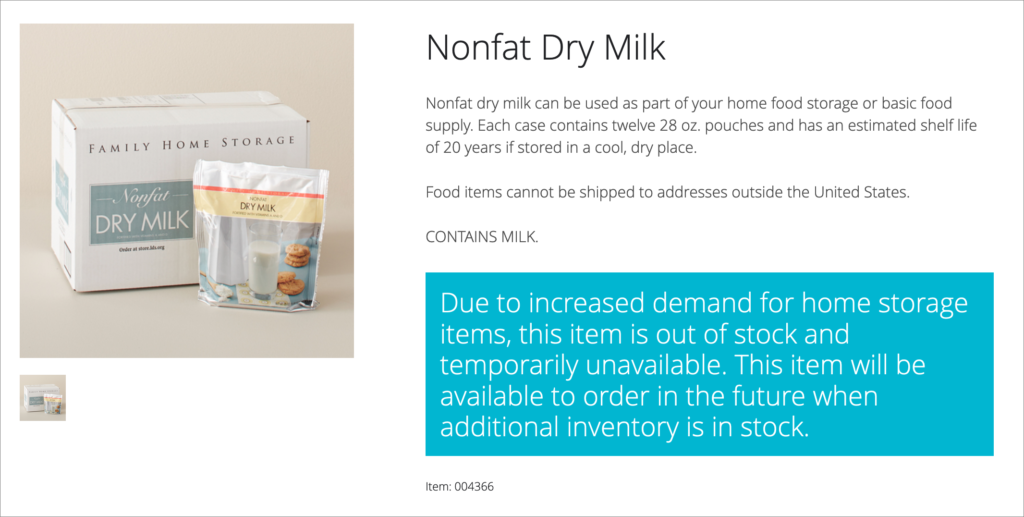The events of 2020 have brought a lot of new preppers into the fold, and many who’ve read our ongoing coverage of America’s food supply problems have contacted us to ask how they can get started by buying a handful of grocery preps with every paycheck. A free ebook, The LDS Preparedness Manual offers a time-tested, well-thought-out weekly food stockpiling plan. (“LDS” is short for “Latter Day Saints.” Also known as the Mormons.)
Mormons are religious about preparedness
We are not endorsing the Mormon religion, but the fact is that Mormons are quite literally religious about preparedness. And as such, they have a wealth of information and baked-in preparedness wisdom, including what foods to store, how to store them, and clever ways to prepare them.
The LDS Preparedness Manual, despite its name, has not been endorsed by the LDS church. In fact, it even at some points recommends stocking up on coffee, tea, and beer, three beverages the LDS church frowns upon. The term SHTF appears several times. The editor of the manual makes it clear up front that it’s for everyone:
At some point while reading this manual you ARE going to have questions, and I am happy to offer my assistance to you, your family, your church or your preparedness group REGARDLESS of your religious affiliation! While I am LDS, preparedness doesn’t care what your religious affiliation is!
Other than some easily skippable front matter, you’re not going to be inundated with blatant religious messaging. Now let’s discuss the book itself.
How to get the LDS Preparedness Manual
There are multiple copies of the LDS Preparedness Manual floating around, but the most recent edition from 2012 is available for free from the publisher, Another Source of Warning. Submit an email address and they’ll send you a link to download the book (use a throwaway email address for privacy if you like). You can also buy a hardcover copy of the book at cost.
The book totals over 500 pages and is a collection of preparedness articles by different authors. There are a number of checklists to evaluate your personal preparedness, lists of foods to keep stocked, guides on how much food to stock, and more.
The article we’ll focus on starts on page 62 of the PDF, Monthly Food Storage Purchasing Calendar by Andrea Chapman.
Using the food purchase calendar
The calendar breaks down, month by month, week by week, what provisions you should buy. The stated goal was to keep the costs between $35-45 per week. However, I have no idea how old this list is. I found an earlier edition from 2001 with the same list, so expect some inflation.
The list is basic and often repetitive. It revolves around the so-called “Mormon Four”:
- Whole wheat berries
- Dry milk
- Sugar or honey
- Salt
If you follow the list to a T, in a year your house will be full of several hundred pounds of wheat, dry milk, sugar, and salt. Other articles from the book recommend between 300-400 pounds of wheat per person, per year (the articles are not always in agreement with each other, but they’re usually close).
As it happens, the Mormons have a thing for wheat. It’s not a bad choice for a preparedness staple. Wheat berries are versatile, calorie-dense, store well, and can even be planted to grow more wheat.
Salt, sugar, and honey are solid things to have at hand. They’re used in many, many dishes, are also useful for preserving food, and last pretty much forever.
The dry milk I’m a bit more skeptical about. It doesn’t last forever. Most off-the-shelf dry milk products expire in a little over a year, though they might be safe to eat for years after that, and some preparedness outfitters sell sealed dry milk that is advertised to last more than 25 years (as long as it remains sealed of course).
My skepticism aside, this is a time-tested food storage plan. Stories abound about Mormons who faced financial hardships but made it through thanks to their food storage.
The purchase plan isn’t limited to the big four. Of course, there’s a mix of rice and beans — of the latter both canned and dry, which is important because in an emergency dry beans take a lot of energy to cook. The list also includes peanut butter, oats, instant potatoes, canned tuna, and canned vegetables, among other things.
While we won’t republish the full plan here out of respect for Andrea Chapman’s copyright, we have compiled a kit, broken out by month, with purchase links for your convenience.
Water is key to this plan, and you are encouraged to stockpile it as much as possible, even filling old soda bottles if that’s all you have. The guide recommends 14 gallons per person, so I included the budget-friendly Reliance Products Aqua-Tainer, which we recommend in our water storage container guide, as each container holds seven gallons of water.
Now let’s discuss the kit and the plan as a whole.
Be ready to make adjustments
First off, I strongly encourage you to take this plan and adapt it to your needs. When creating the above kit, I tried to stick as closely to the published plan as possible. Unfortunately, that also means that some months are much more expensive than others. When viewing the kit, you can click Make a New Copy to create your own personal copy that you can rearrange and edit to your heart’s content.
However, the plan is pretty flexible. The author acknowledges that you may not buy everything on the list in a given month, and encourages you to go back and stock up on those items later on.
Even if you’re flush with cash, supply chain issues may mean that you can’t buy exactly what you want when you want it. Also, you will want to review the manual’s guidance for food storage and adjust for the size of your household.
You also want to make sure you’re buying foods that your family will eat. A survival situation is no time for fussy diets or picky eaters, but some people can’t tolerate gluten, lactose, or peanuts. Make substitutions where necessary, but make sure that your replacements are versatile and can store well.
The guide is somewhat seasonal and encourages you to look to buy things on sale. In my experience, these sorts of sales aren’t that predictable, so I would encourage you to keep your eyes peeled for good deals and change up the plan to take advantage of them.
The list is merely a suggestion, and the kit is a suggestion of a suggestion.
Learn to use your stockpile
Next, you need to be able to cook from scratch. And I mean scratch because almost everything in this list is a raw ingredient. If you don’t already know how to cook, consider taking it up as an essential prep skill. Pinto beans and wheat berries store much better than frozen pizzas and potato chips.
Even if you’re an experienced cook, you may be asking yourself, “What am I to do with all these wheat berries and milk powder?”
One thing you will need that I did not include in the kit is a grain mill that will turn your wheat berries into flour. I do not have enough experience to recommend a specific grain mill. You can buy either an electric or a manual mill, and if you can swing it, I recommend both: the electric for convenience and the manual in case of a grid-down scenario. I’ve considered the Country Living Grain Mill, since it can be paired with an optional motorization kit, but that pair would cost nearly $1,000. I’ve also heard good things about the NutriMill electric mill, and it’s much cheaper (though still not cheap).
You may be tempted to skip the berries and buy pre-ground whole wheat flour. Don’t. Whole wheat flour does not store well, nor do many other “brown” dry goods like brown sugar and brown rice. White flour is in the list and you can bulk up on your stockpile there if you must.
Thankfully, because Mormons tend to stockpile those basic four foods, they’ve also published a number of resources on how to use them, such as the free ebook, New Ideas for Cooking with Basic Food Storage, which includes a number of recipes for the wheat berries and dry milk. The book is thankfully organized by raw ingredients.
In month 6 of the guide, there is an assumption that you will be making your own dairy products like cheese and sour cream, thus the lemon juice, vinegar, and rennet. I encourage you to learn these skills, but I can tell you from my wife’s experiments, these are skills that will take time to develop. The rennet I linked to in the kit is from Steve the Cheesemaker, who is highly regarded by our cheese-making friends.
Another thing that might be new to you is the concept of sprouting seeds, which is an easy way to get some fresh vegetation into your diet and it maximizes the nutritional value of legumes. Page 129 of the PDF offers a quick guide to seed sprouting. St. Paul Mercantile sells a three-tray seed sprouter for $7.50. Sprouting seeds is much easier than making cheese: add sprouting seeds, add water, and wait.
The guide also recommends garden seeds. To that end, I recommend the Baker Creek Heirloom Seeds. Baker Creek heirloom seeds are highly regarded and I’ve had excellent results with them.
Just as you want to give the items in your go-bag a trial run before an actual emergency, you want to practice cooking with this stuff before you have to. Unfortunately, you’re buying into a lifestyle with this plan, because these ingredients, especially the dry milk, won’t last forever. You’ll want to use and replenish them regularly, practicing “first in, first out,” where you use your oldest items first to prevent spoilage.
The only spices on the list are salt and pepper, but I encourage you to build your spice stockpile because they can dramatically increase your options. I can turn canned tomatoes into either an Italian, Mexican, or Indian dish, with most of the same ingredients, just by switching up the spices I use. Page 54 in the PDF suggests some spices to stock up on, though I’m not a fan of garlic salt because I’d much rather have powdered garlic and salt as separate ingredients.
I also encourage you to add variety to the list. Maybe one week you buy a big bag of pinto beans and the next a bag of black beans. I include general-purpose rice in the kit, but at our house, we not only keep that around but also basmati rice for Indian dishes and jasmine rice for Thai dishes. You might think rice is rice, but the type can make a big difference, especially basmati. A biryani just isn’t the same with shorter rice, and a plate of fried basmati is just odd, at least to me.
You also need to learn about how to store and preserve your food. The guide encourages purchasing goods in #10 sealed cans, which are good to go for shelf-stable storage. For other dry goods, the guide recommends buckets, and I’ve incorporated bucket purchases into the kit, along with an inexpensive bucket opener. However, you may also want to consider investing in mylar bags and oxygen absorbers. Jump to page 137 of the LDS Preparedness Manual PDF for more info on that. I’m currently learning that method myself and will share more soon.
Speaking of budget, the kit totals around $3,800. Yes, that’s a lot of money, but there are multiple ways to reduce that cost.
Saving money with the food storage plan
When building the kit, I aimed to find the best prices at common stores like Amazon and Walmart. There are a few occasions where I link to Sam’s Club, which requires a membership because the price was dramatically better than the more-available options. Costco is also an excellent option, but we have a membership at Sam’s because there are more of those stores in our area. Both Costco and Sam’s Club offer membership deals with free shipping, but unfortunately, the best deals on bulk foods are going to be in the store.
Generally speaking, the membership-based warehouse stores are going to give you a better deal on bulk items, but not always! For example, Sam’s will sell me 50 pounds of pinto beans for just under $45—about 90 cents per pound, but only if I walk into a store. Due to COVID-19 precautions, we buy our pinto beans from Walmart, but we only get eight pounds for $6. That’s actually cheaper than Sam’s at 75 cents per pound, but not nearly as convenient. When you buy large quantities, a few cents here and there can quickly add up, so it pays to shop smart (even if you can’t shop S-Mart).
Another potential option for you is a local grain mill, which might be much cheaper than a grocery or warehouse store, and buying local makes you a bit less dependent on the global supply chain. You may also have local Amish or Mennonite communities with stores that sell dry goods in bulk at reasonable prices.
Naturally, the LDS church has systems in place to help its members build their required stockpiles. They have an online store that sells pretty much everything you’d want in a #10 can: wheat, flour, rice, sugar, carrots, onions, and of course, dry milk (though it comes in a pouch, not a can). And you don’t have to be a member to place an order. But even the Mormons are having supply chain issues.
Another option is the LDS Home Storage Centers. They used to be called canneries because you’d either can your own goods on-site or rent a canner to use at home. The church had to end that practice and now instead sells prepackaged foods, usually in #10 cans. Of course, most of the locations are in Utah, but there are Home Storage Centers all over the United States.
If you go that route, please call ahead first. These places have odd hours, and even before the COVID-19 pandemic, some required an appointment. I’ve heard reports that some are only doing curbside pickup. And while they are usually open to everyone, I’ve also heard reports that some are limiting their supply to LDS members while supply chains are tight. If you do visit a Home Storage Center, be a good guest: dress conservatively and refrain from smoking and foul language. When in Rome…or Utah as it might be.



You are reporting the comment """ by on